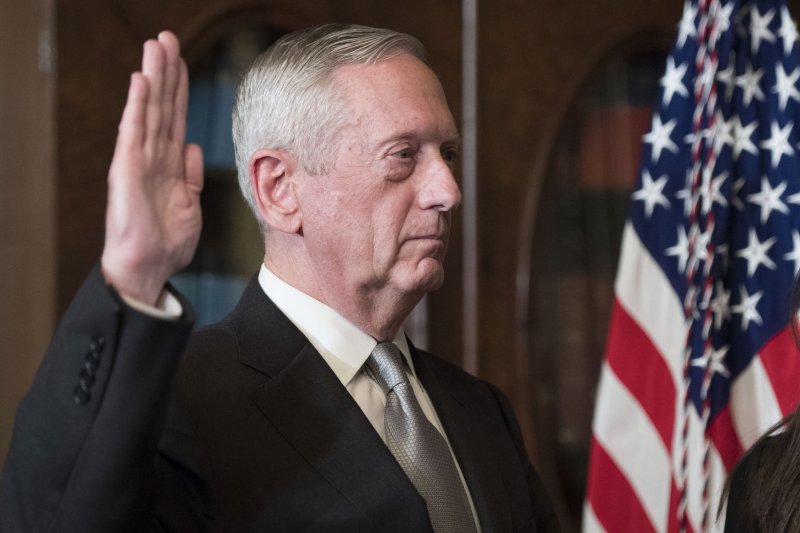Marine Corps Gen. James Mattis is sworn in as defense secretary on January 20. In a confirmation hearing, Mattis promised that his themes would be "solvency and security." Photo by Kevin Dietsch/UPI |
License Photo
In the early 1980s, U.S. Army Chief of Staff Gen. E.C. "Shy" Meyer warned of "a hollow force," that is a depleted military untrained, ill equipped and unready to carry out its responsibilities. Lack of defense spending was the culprit.
Make no mistake: That is happening again. Unless action is taken now, the U.S. military will become "hollow." The major culprit this time is uncontrollable internal cost growth.
At the Senate confirmation hearings on retired Marine Gen. James N. Mattis' nomination for secretary of defense, not one word about this looming danger was raised. Much was made about the clear and present danger of a resurgent Russia and China. North Korea remains a very serious problem. While the Islamic State is losing territory, its menace is far from over. Nor can the insanity of sequestration that arbitrarily imposes automatic cuts across all Pentagon programs be ignored.
In his remarks, Mattis promised that his themes would be "solvency and security." His top priorities are to strengthen military readiness, force lethality and our alliances, and bring about business reform instilling budget discipline by making leaders accountable. The Senate overwhelmingly and happily confirmed the general.
These priorities and other contingencies must be met with appropriate responses. But understand that uncontrollable internal (real) cost growth of about 5-7 percent a year, a figure calculated by the Pentagon's Business Board, currently amounts to between $30 billion and $40 billion annually. At 7 percent, these costs will double every decade.
With a $600 billion-plus annual defense budget, Congress is unlikely to approve yearly increases at this level and fund a larger force. Much internal cost growth is for people, including healthcare and retirement. However, virtually every item in the budget from precision weapons to pencils is affected. The symptoms of a hollow force are already visible.
Many reasons explain why internal cost growth above inflation persists. Maintaining a highly trained well-equipped all-volunteer force is very expensive. Costs of new technology that provides extraordinary military capability are another. Myriad acquisition regulations to limit abuses are obscenely costly in time and money. And Congress' refusal to pass serious base closing and other efficiency measures likewise contribute to systemic cost growth.
Indeed, it is a wonder that the Pentagon works as well as it does. Consider three small examples of this exploding cost phenomenon. A single F-35 pilot's helmet -- a technological marvel -- costs nearly half a million dollars. Pilots get two. Before cancellation, a single 155-mm round for the Navy's newest Zumwalt class warship with a 100-mile range and pinpoint accuracy costs about $1 million. And the Army was required to spend about $150 million on research and development for a new pistol -- when the entire force could have been equipped with a satisfactory weapon at a much lower cost.
The new administration has promised to "rebuild" defense, adding tens of thousands more ground forces; expanding the Navy to 350 ships; and growing air strength to 1,200 fighters. This buildup will require annual budgets approaching $800 billion, nearly a 1/3 hike over time. But without addressing internal cost growth issues first, these proposed increases will, ironically, accelerate the onset of a hollow force.
An analogy is building an expensive extension to one's home when major repairs to the original structure are essential but deferred or ignored. The result is a less livable home. A similar outcome will consume defense.
Fortunately, internal cost growth can be contained. Before the new administration's defense increases are initiated, careful analysis must be made to determine why a larger force is vital and will contribute to enhancing national security and, critically, how it will be paid for and sustained.
Second, Congress must be part of the solution. Here, streamlining and consolidating defense acquisition regulations and a serious base closing round are essential.
Third, changes to personnel accounts for pay, healthcare and retirement must be imposed to lower costs.
Fourth, once a weapons systems is approved, to control requirements creep and cost overruns, unless program success or failure is at stake, changes in requirements will not be made.
Mattis understands that uncontrollable cost growth inevitably breeds a hollow force. Unfortunately, the political-bureaucratic-defense-industrial complex that defines the what, why and how of "raising an army and maintaining a navy" is not only indifferent to this destructive interaction. It is largely its cause.
Every one of Mattis' considerable skills will be needed to halt the return to a hollow force.
Harlan Ullman is a senior adviser at Washington D.C.'s Atlantic Council and Business Executives for National Security and chairman of two private companies. His next book, due out this year, is "Anatomy of Failure: Why America Loses Wars It Starts," which argues that failure to know and to understand the circumstances in which force is used guarantees failure. Follow him on Twitter @harlankullman.















